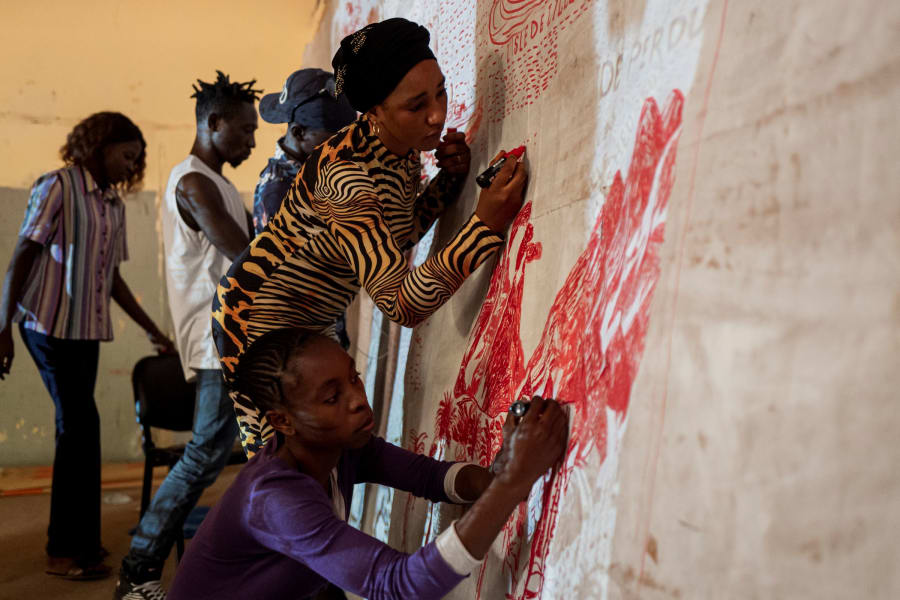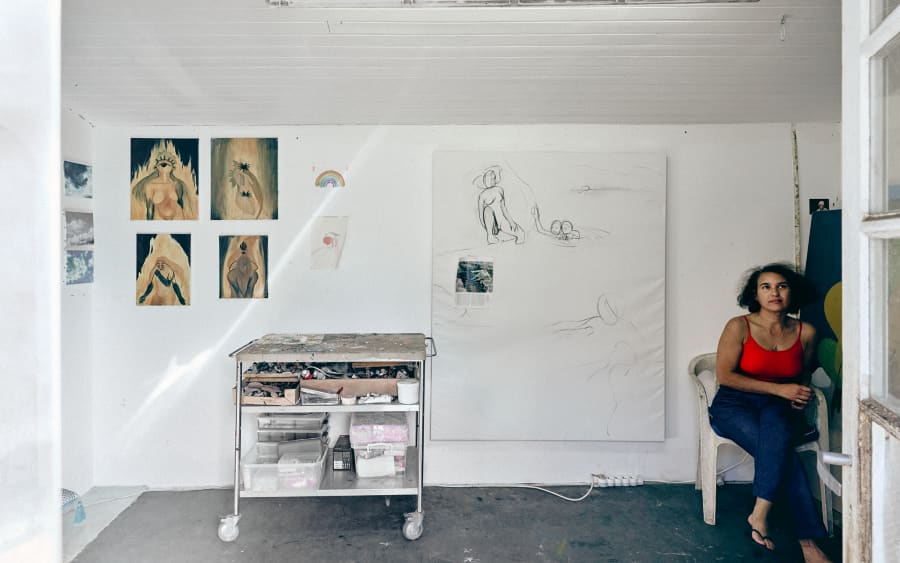One detail stands out in the resumé of Salimata Diop, the artistic director of the new edition of the Dakar Biennale: She is not only an art critic and curator, but also a composer and pianist. And it is precisely this musical element that she drew upon for her biennale, which is entitled ‘The Wake: Awakening, Xàll wi’. ‘In my conception of the biennale, musical notes came before words,’ she explains.
Diop’s career thus far is marked by her commitment to eclecticism. ‘The most important thing for me is to make connections between artworks, places, and artists,’ she says. With a Senegalese father and French mother, both linguists, Diop was born in Dakar and grew up in Saint-Louis, Senegal, before studying literature at the Sorbonne in Paris, and art history at Warwick University in the UK. She began by making film portraits of artists for the ‘African Masters’ television series (El Anatsui, Mary Sibande...). After which she became director of the Africa Centre in London, and the Also Known As Africa (AKAA) fair in Paris. Then in 2017, with the collector Amadou Diaw, she created the Musée de la Photographie de Saint-Louis (MuPho), which she lead until 2018.
After an unprecedented postponement, due to political tensions, the Dakar Biennale opens on November 7. ‘We were very afraid for democracy in Senegal. Now we’re back to a functioning democracy. The forthcoming legislative elections are a major challenge for the new regime. As for the biennale, we are fighting to retain its status, budget, and the venues it has today,’ explains Diop.
The main location is the former Palais de Justice. ‘This “monster of a palace,” with its majestic architecture, was inaugurated in 1957 for the capital of French West Africa. For the biennale, I imagined a shipwreck linked to the international political and environmental situation. This gave rise to the idea that we had to wake up. Together with the set designer Clémence Farrell, we imagined a somewhat punkish itinerary, with original installations in the Salle des pas-perdus, and four ‘chapters’ in the smaller spaces on the upper floors: Nager dans le sillage [Swimming in the wake], Plonger dans la forêt [Dive into the forest], Flotter dans le nuage [Floating in the clouds], Brûler [Burning].’
For Art Basel, Diop highlights four artists who should be on everyone’s radar.
Ghizlane Sahli
b. 1973 in Meknes, Morocco. Lives and works in Marrakech.
‘I’ve wanted to collaborate with Ghizlane Sahli for several years. She is a Moroccan artist whose magnificent work with materials – often recycled – sometimes borrows from ancestral practices such as embroidery. I’m very attuned to the techniques and materials that artists choose. The textures of her works, made of fabrics and pearls, are reminiscent of coral and the seabed. For the biennale, visitors are invited to explore a flower garden as if it had become tiny. We stroll through a labyrinth, as if between microscope slides. In reality, little pistils reach heights of 2 meters. You feel as if you’re entering the flower, seeing both its perfection and complexity. It’s a project about changing perspectives, dimensions, and scales, influenced by architecture and design, and one that induces a sense of humility.’
Laeïla Adjovi
b. 1982 in Benin. Lives and works in Dakar.
‘Trained as a journalist, Laeïla Adjovi has developed a body of work that pursues new approaches to photography. I’ve been working with her for a long time and have included her in several exhibitions I’ve curated, such as the inaugural exhibition at MuPho in Saint-Louis, in ‘Chants invincibles’ in an offsite project at the Dakar Biennale in 2022. In 2018, she was awarded the Grand Prix Léopold Sédar Senghor at the Dakar Biennale: this new edition is therefore her return to the former courthouse. She presents Cotton Blues, a long-term project for which she documented cotton growing in northern Benin. She then developed her cyanotype photos on cotton fabric from Benin, using sunlight. When you enter her space, you enter a cocoon, somewhere between a spider’s web and a bird’s nest. Interwoven cotton threads form the entrance to a cave. We see cotton in all its forms.’
Dalila Dalléas Bouzar
b. 1974 in Oran, Algeria. Lives and works in Bordeaux, France.
‘Dalila Dalléas Bouzar is one of the artists I’ve talked to the most for the biennale, as her project has developed considerably over time. She will show a diverse body of tapestries, drawings, and paintings that will speak of injustice in a muscular, combative, and powerful way. It will be a series of faces that are even more poignant than her usual work: portraits of children being killed by bombs, an image of primeval injustice. She has also included texts in these works, which touched me deeply. In a large embroidered tapestry, over two meters long, she has written a poem, like a letter to the world, accompanied by a silhouette in which she has inserted stones and beads. Whatever form it takes, you can always recognize Dalléas Bouzar’s signature.’
Tuli Mekondjo
b. 1982 in Angola. Lives and works in Windhoek, Namibia.
‘Known as a painter, embroiderer, and performer, Tuli Mekondjo is a self-taught artist born to Namibian parents in exile in the camps of Angola, who returned to Namibia after independence in 1990. She shows a video based on a performance about Namibia’s conversion to Christianity. Through these images, Mekondjo reflects on how and why her ancestors converted, and the way in which the loss of ancestral beliefs, erased by colonization, has affected their relationship with nature in their homeland. On the opening day of the biennale, she will give a ritual performance in which she seeks to “reconnect with the spirits of her ancestors using the tools of the present, such as video.”’
‘The Wake: Awakening, Xàll wi’
From November 7 to December 7, 2024
Dakar
Anaël Pigeat is an art critic, editor-at-large at The Art Newspaper, contributor to Paris Match, and an independent curator.
Caption for header image: View of Dakar, photograph by Prince Debiz N’kouka Bizenga aka Bizengabiz for Art Basel, 2022.
Published on November 6, 2024.


